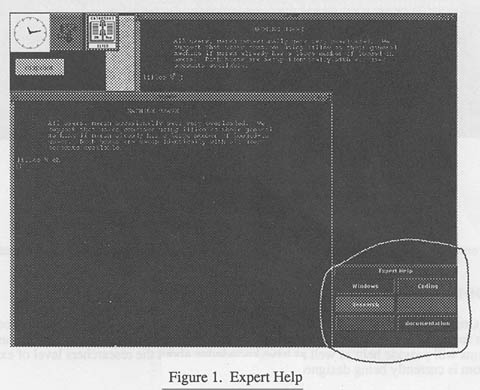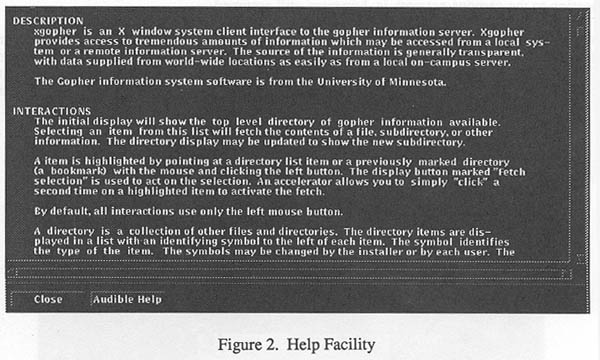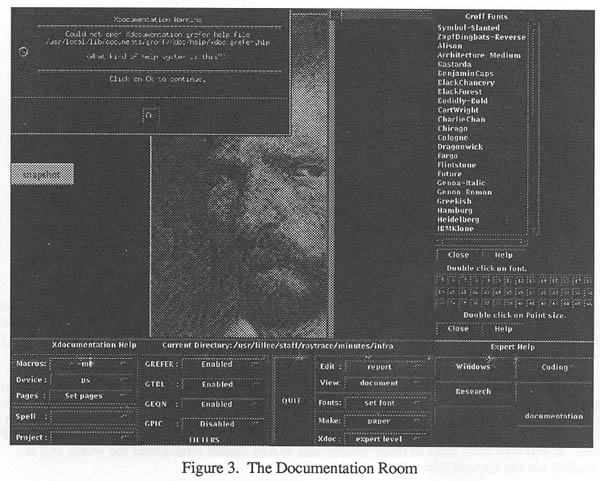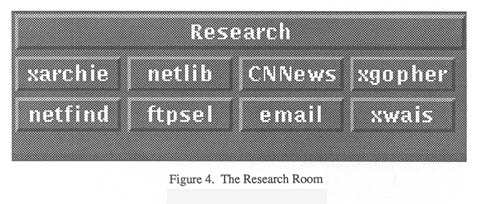
Jocelyn Armarego & Andrew Marriott
School of Computing
Curtin University of Technology
Perth, Western Australia 6102
E-Mail: JOCELYN@MARSH.CS.CURTIN.EDU.AU
E-Mail: RAYTRACE@MARSH.CS.CURTIN.EDU.AU
Abstract: Developments in information technology mean information professionals can provide a level of service previously unattainable without great effort. However, the proliferation of technology in everyday life means that the library client's expectations of the use of technology to provide for his/her needs is also high. To a certain extent the library must make use of information technology to fulfill these needs. But while the newest products and services are exciting, they are also costly and stretch thinner an already overstretched budget. Overall, libraries are required to provide more with less.
In the environment of a tertiary institute, the ability to provide computer aided support for the diverse information requirements of final year, honors and post-graduate students undertaking research projects helps to redress the imbalance. That this support utilizes easily accessible technology and services is an added bonus.
This paper describe the design and development of Expert Help, a computer system to aid students in all aspects of project work on a multimedia platform. As developed, the system is intended to be extensible: we hope that others will add their expertise to the system. It would seem that the first stage of Expert Help could be an appropriate tool for academic libraries to make available to their clientele at minimal cost.
Developments in information technology mean information professionals can provide a level of service previously unattainable without great (usually manual) effort. However, the proliferation of technology in everyday life has led to a situation where the library client's expectations of the use of technology to provide for his/her needs is also high. To a certain extent the library is obliged to make use of information technology to fulfill these needs. It is put in the position of having to maxi-mize the use of all available and developing technologies for its operations. But while the newest products and services are exciting, they are also costly and stretch thinner an already overstretched budget. Overall, libraries are required to provide more with less.
A partial solution to this problem is available. Goodram and May (1991) discuss the concept of a V-Library (Virtual Library) by which the information resources of other institutions are made availa-ble to the library. However, Goodram and May discuss the concept in terms of relationships with other libraries only. In their narrow definition of the term, there is a requirement for institution-to-institution financial and service agreements, as well as the the computer and communications techno-logies that provide the access and transmission pathways.
It is feasible, however, to advance the concept of the V-Library without the need for tight con-tractual relationships. Information is freely available through connection to electronic networks that now either span the globe or themselves allow connection to other networks in order to span the globe.
In the environment of a tertiary institute, the ability to provide computer aided support for the diverse information requirements of final year, honors and post-graduate students undertaking research projects helps to redress the imbalance of trying to provide more with less. That this sup-port utilizes easily accessible technology and services is an added bonus.
2. SYSTEM OVERVIEW
This paper examines the development of ExpertHelp, a computer system to aid students in all aspects of project work on a multimedia platform. It provides support in the early stages of research through knowledge of
• effective use of electronic mail (email)
• searching for data at anonymous ftp sites via software such as archie
• the electronic news system (receiving and posting) and appropriate groups
• online Library services and bibliographic searches
• maintaining and referencing bibliographic databases.
The design and write up stages of a project are also supported. ExpertHelp will be available on:
• the appropriate strategy for planning and research
• automated critical path analysis
• diagram preparation
• document preparation for phototypsetter quality output.
• the publishing of papers in journals in required formats.
The development of a system to provide these services, and their technology requirements, form the basis of this paper.
3. TECHNICAL OVERVIEW
As originally proposed, the system was to use an Iris Indigo workstation which supports full colour high-resolution high speed graphics, 16 bit digital stereo sound, hyper-media type software as well as desk top publishing software. The machine is connected to the campus network which means world access for electronic mail, news and file retrieval through Internet.1 The design is now based on machine-independent features, including workstation independent graphics and audio. Connection to the campus network is, however, still assumed.
With ExpertHelp a student/researcher will have their normal workstation windows and can run a virtual room system (Figure 1 lower right hand corner). The ExpertHelp Graphical User Interface (GUI) is based on the code for Vr [1] and appears in each room in the position shown. Each room also contains a clock, an electronic mail GUI (XMailtool [2]) and an appointment / project manage-ment GUI (Calentool [3]).

By clicking on the appropriate button the student/researcher will be moved to a room which is set up for that type of expert help. The "Expert Help" button at the top of GUI will give visible and audible help about the ExpertHelp System.
Associated with each subsystem throughout ExpertHelp is a series of scrollable help windows (see Figure 2). It is proposed that the researcher will be able to designate him/herself as novice or familiar system user, and obtain the level of ExpertHelp required. For example, a novice user may not know the procedures for subscribing initially to relevant news groups. In this case, ExpertHelp takes over and initiates the service.

Currently ExpertHelp Rooms have been set up for Coding, Documentation and Research.
4. CODING ROOM
The Coding Room will help researchers in developing and maintaining their source code. It will use tools for revision control, software quality control and standards compatibility. As usual, these subsystems will provide help as well as have knowledge about the researchers level of expertise. This Room is currently being designed.
5. DOCUMENTATION ROOM
Figure 3 shows the Documentation room (please excuse Vincent peering from behind the win-dow he is one of the user-definable workstation backgrounds). This Room allows the user to use the groff [4] typesetting system. The various buttons produce help, set resources, run programs, etc which reduce the amount of "learn" time for a new user. For example, users may set the font and point size of the typeset document simply by clicking rather than having to worry about what font is available and at what point size. Any error messages (such as shown) appear in a consistent way.
The system lets a user install an environment for each document to be produced - novices will be guided. The environment lets a user select the pages produced, check spelling of all parts of the document, produce draft copies of documents, produce photo-typsetter quality output, tidy up the document area and to archive the document area. It also enables users to build and reference their own bibliographic databases. Help is available for the production of images scanned in, computer drawn or computer generated.

The system is also user-extensible in that facilities are available for setting and subsequently choosing a menu item from the Xdoc submenu (lower right hand corner). Initially the system will only know about the groff typesetting system, others may like to include information about other typesetting / desk top publishing systems such as LaTeX.
6. RESEARCH ROOM
Each button of the Research Room (see Figure 4) allows access to the relevant service. At present, the Research Room has ftp [5], xarchie [6], xgopher [7], xwais [8], email [9], netfind [10], netlib [11] and news [12].
A typical research session may start with the user reading the electronic news groups or using xgopher and reading of a piece of software or a document. xwais could then be used to find out more about the information, xarchie could be used to find all ftp sites which have that information; the nearest site indicated by xarchie would provide the Internet address and directory and ftpsel could be used to get the information. Follow-up information could be posted to the appropriate news group or sent to relevant researchers on the network via email. If their email address is not known then netfind can help.

The information could then be used in the Coding Room if it is software or in the Documentation Room if it is a paper or journal article. Since all this can happen concurrently, it is possible to con-tinue reading news or gophering and to follow-up the next piece of relevant information before you have finished retrieving the first! subsystems.
A gopher server has been set up in our School as part of the Research Room. This has been done in consultation with the Computing Centre, the Library and other tertiary institutions. This allows access to technical reports produced within our School as well as other information such as Computer Graphics images, Public Domain software (see Appendix I), Honours, Masters and PhD theses. It will also have links to other gopher and WAIS clients throughout the world and is accessible via the ExpertHelp xgopher subsystem.
7. CONCLUSION
It is becoming obvious that the academic community (except for some of those directly involved in computing) is largely unaware of the information resources available through electronic network links, and of the implications for research and scholarly communications of the network services provided.2
The student researchers are even further removed from valuable information if their supervisors cannot aid them in accessing these resources.
It would seem that the Library has a role to play in making this type of information easily available and that the subsystems of the Research Room of ExpertHelp could be an appropriate tool for academic libraries to make available to their clientele at minimal cost.
As developed the system is intended to be extensible: we hope others will add their expertise to ExpertHelp.
REFERENCES
Goodram, Richard J. & May, James H. (1991). "The
E-Library: An intelligent environment for expert systems," In Libraries
and Expert Systems: Proceedings of a Conference and Workshop , edited
by C. McDonald & J. Weckert. London: Taylor Graham, 1991. pp. 115-129.
APPENDIX I. PUBLIC DOMAIN INFORMATION SOFTWARE
[1] Vr
Virtual room software which enables one workstation screen to cater for many separate "rooms" of information and services. To switch rooms simply click on the toggle button corresponding to that room. You can:
• allow some programs (titles) to span all rooms
• have some programs started up in a given room at startup
• have some programs started up in a given room at switchover.
Email addresses:
Comments, suggestions and bug reports: Rich Mauri (rmauri@netcom.com)
Anonymous ftp: mcsun.eu.net (192.16.202.1)
Directory /windows/X/R4.contrib
File: vr-1.1.tar.Z
[2] Xmailtool
Xmailtool is a graphic interface to the BSD style mail reader. It essentially provides the user with a point and click way of reading and manipulating E-mail. It supports most of the commonly used commands within mail as well as a number of features that mail can't possibly support.
Email addresses:
Comments, suggestions and bug reports: bobo@cray.com
keith@cray.com
Anonymous ftp: ftp.uu.net (137.39.1.9)
Directory: /packages/X/contrib
File: xmailtool.tar.Z
[3] Calentool
Calentool is a day/week/month/year-at-a-glance calendar used for appointments and project management.
Email addresses:
Comments, suggestions and bug reports: billr@saab.cna.tek.com
Anonymous ftp: ftp.uu.net (137.39.1.9)
Directory: /pub/window-sys/X/contrib
File: calentool2.2Xp1.tar.Z + calentool2.2X.pch1.Z
[4] Groff
GNU groff is the freely available document formatting system which looks like the Unix Troff system. Included in the system are implementations of troff, pic, eqn, tbl, refer, the -me, -man, -ms and -mm macros, and drivers for PostScript, TeX dvi format, and typewriter-like devices.
This paper was originally formatted and typeset using groff.
Email addresses:
Anonymous ftp: wuarchive.wustl.edu (128.252.135.4)
Directory /mirrors2/gnu
Filenames: groff-1.06.tar.Z
[5] File Transfer Protocol
Ftp is the standard method for transferring files between different computer systems on Internet. Anonymous ftp enables an organization or institution to make information (programs and docu-ments) freely available to people on the Internet without them needing an account or password. You will need the name or Internet number of the machine required (see archie below).
[6] Archie
Archie is a system developed at McGill University in Canada to maintain a list of archive sites which provide an anonymous ftp services on Internet.
The archie service is a collection of resource discovery tools that together provide an electronic directory service for locating information in an Internet environment. Originally created to track the contents of anonymous ftp archive sites, the archie service is now being expanded to include a variety of other on-line directories and resource listings.
Users can access an archie server either through interactive sessions (provided they have a direct Internet connection) or through queries sent via electronic mail messages (provided they can at least gateway electronic mail messages onto the Internet).
Interactive access to archie may be through a conventional telnet session to a machine running an archie server or through a program that has been integrated into a larger system, such as the Prospero network distributed file system.
Peter Deutsch,
Computing Centre, McGill University.
Programs such as Xarchie (an X-Based graphical front end to archie) exist which integrate an archie client with anonymous ftp file transfer facilities allowing a user to first locate and then obtain information from archie sites.
Users with direct Internet connectivity can try out an interactive archie server using the basic "telnet" command (available at most sites). To use, telnet to the host "archie.mcgill.ca" [132.206.2.3] and login as user "archie" (there is no password needed). First-time users should try the "help" command to get started.
Email addresses:
Archie Xarchie
Comments, suggestions &bug reports: archie-l@archie.mcgill.ca Anonymous ftp: ftp.uu.net (137.39.1.9)
Mailing List: archie-people@archie.mcgill.ca Directory/usenet/comp.sources.x/volume14/xarchie
Anonymous ftp: quiche.cs.mcgill.ca (132.206.2.3) (Or use archie to find out nearest copy is via anonymous ftp!)
Directory /archie/clients
[7] Gopher
A uniform user interface to a number of other Internet services as well as a considerable amount of text information online. This includes electronic journals, technical reports, images, software, etc.
The Internet Gopher uses a simple client/server protocol that can be used to publish and search for information held on a distributed network of hosts. Gopher clients have a seamless view of the information in the gopher world even though the information is distributed over many different hosts. Clients can either navigate through a hierarchy of directories and documents -- or ask an index server to return a list of all documents that contain one or more words. Since the index server does full-text searches every word in every document is a keyword.
Gopher Readme
If you want to test gopher, you can telnet to consultant.micro.umn.edu and log in as "gopher".
Email addresses:
Comments, suggestions and bug reports:
gopher@boombox.micro.umn.edu
Anonymous ftp: boombox.micro.umn.edu (134.84.132.2)
Directory: pub/gopher
[8] Wais
A client-server system developed by Thinking Machines Inc for easy information retrieval from over 140 information resource servers. The system uses natural language questions asked by the user to locate relevant documents. Very useful for key word searches of (technical) documents.
With this tool, documents are retrieved by starting with a question in English. A single line, or headline, would describe possible documents that are appropriate. These documents can be viewed, or used to further direct the search by asking for "more documents like that one". Each document on the disk (or some other source) is then scored on how well it answers the question and the top scoring documents are listed for the user. Since full natural language processing is currently impossible, each document type, be it a newspaper article or a spread sheet, must have some simple measure to determine how relevant it is to the question asked. For text documents a useful and powerful measure is to count the number of words in common between the question and the text. This well known technique of Information Retrieval can be augmented with different weighting schemes for different words or constructions. Other types of information might be retrieved with specific question formats.
Thus, documents can be found by asking the "navigator" for documents that contain a set of words. Those documents that share the most words with the question will come back at the top of the list (have the best "score"). In this system the "answer" to a question is not a single document, rather it is an ordered list of candidate documents.
Wais Document
Email addresses:
Comments, suggestions and bug reports: Morris@Think.COM
Anonymous ftp: quake.think.com (192.31.181.1)
Directory: wais
Mailing List: wais-discussion@think.com
[9] Email
Electronic mail available through network connections. Users will have a unique address as given by their user name, their machine name and their domain name. In my email address raytrace@marsh.cs.curtin.edu.au where raytrace is my user name, marsh is the machine I use and cs.curtin.edu.au is my domain. To talk to anyone on the network you simply need their email address (see netfind below).
[10] Netfind
Given the name of a person on the Internet, and a rough description of the workplace, netfind attempts to locate information about that person including their email address.
Email addresses:
Comments, suggestions and bug reports: schwartz@cs.colorado.edu
Anonymous ftp: ftp.cs.colorado.edu (128.138.243.151)
Directory: pub/cs/distribs/netfind
[11] Netlib
A system which links library online catalogue systems. Access is made available to academic libraries in Australia, and, through LIBS and HYTELNET, Internet Access Software to other online services and libraries throughout the world.
Email addresses:
NETLIB
Unix
Comments, suggestions bugs: huck@csuvax1.csu.murdoch.edu.au
Anonymous ftp: infolib.murdoch.edu.au (134.115.80.10)
Directory: pub/soft/netlib
Filenames: netlib, netliboz, ozmenu
Directory: pub/soft/hytelnet
Filenames: hyteln62.zip hytelnet.tar.Z
Directory: pub/soft/libs
Filenames: libs.sh
Mailing List: syslibs@library.adelaide.edu.au
VMS
Comments, suggestions bugs: k_stott@fennel.cc.uwa.edu.au
Anonymous ftp: infolib.murdoch.edu.au (134.115.80.10)
Directory: pub/soft/netlib
Filenames: NetLib.com, NetLiboz.com, ozmenu.com
Directory: pub/soft/hytelnet
Filenames: hyteln62.zip hytelnet.tar.Z
Directory: pub/soft/libs
Filenames: libs.com
HYTELNET
Comments, suggestions and bug reports: scott@sklib.usask.ca (PC)
fogel@sask.usask.ca (Unix)
Anonymous ftp: access.usask.ca (128.233.3.1)
Directory: pub/hytelnet
Mailing List: LIB_HYTELNET@sask.usask.ca
LIBS
Comments, suggestions and bug reports: resmer@sonoma.edu
Anonymous ftp: mvax.sonoma.edu (130.157.2.5)
Directory: pub
Filenames: libs.sh (Unix)
Filenames: libs.com (VMS)
Mailing List: inet-opacs@sonoma.edu
[12] News
News or Netnews is a network-wide distributed bulletin board and conferencing system. News items are posted in news groups and disseminated to whoever has (freely) subscribed to that group to enable an open forum discussion. Since most academics read the appropriate news group for their field personal contact can be made between a new researcher and a key person in the field.
Comments, suggestions and bug reports: resmer@sonoma.edu
Anonymous ftp: ftp.uu.net (137.39.1.9)
Directory: /networking/news/nntp (News daemon)
Directory: /networking/news/readers (News readers)